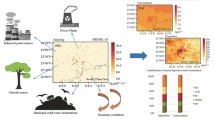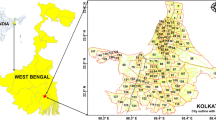Abstract
The purpose of the study was to refine the grid resolution from previous regional level assessments by reducing the latest “standard” 12 km down to a 4 km grid level in a novel application of the CMAQ modeling system on an annual timescale. The application was to determine the overall acidic and mercury deposition over New York State (NYS) and the contribution of the NY power sector point sources. To that end, the latest available EPA NEI for 2011 and WRF simulated meteorological data were generated on the 4 km grid domain over the Northeastern US centered on NYS. For mercury, emissions of the elemental, oxidized and particulate species were characterized using stack test and technology based data to allow for the proper assessment of the relative contribution from EGUs and WTE facilities using species dependent wet removal factors and dry deposition velocities. The results for mercury deposition indicate very low contributions from total NYS sources, but shows the importance of both wet and dry components. The impacts of emissions outside the modeling domain were found to clearly dominate total depositions in NYS. For acidic deposition, the importance of wet deposition for sulfate is found, while for total sulfur and nitrates, dry deposition has a significant contribution. For NYS power sector, the significant contribution of dry deposition of SO2 is highlighted. The projected total wet depositions of sulfate, nitrate and mercury compare very favorably with observed levels at NADP sites.
Access provided by CONRICYT-eBooks. Download conference paper PDF
Similar content being viewed by others
Keywords
- CMAQ modeling system
- Acidic and mercury deposition
- Refined regional grid
- New york state major source impacts
- WRF meteorological simulations
1 Introduction
As recent United States Environmental Protection Agency (USEPA) and New York State (NYS) policy and regulatory approaches have emphasized the importance of the interaction of multi-pollutants, the need has shifted to more comprehensive techniques to ascertain their impacts. Requirements to reduce toxics such as mercury from power plants and the importance of sulfate and nitrate transport in the eastern United States have taken center stage at the USEPA. Recent rules have relied heavily on regional-scale photochemical model applications and affect emissions from energy production sources such as Energy Generation Units (EGUs) and waste to energy (WTE) facilities. However, technical assessments for these requirements have not been commensurate with the latest emissions data and the techniques necessary to properly assess their implementation. That is, these assessments have relied upon outdated simulations using past emission inventories and coarse meteorological fields.
Most germane to the current study was the recognition that past modeling studies have not fully quantified current and future contributions of New York’s power generation sector to the regional acidic and mercury depositions. In addition, there has been a shift in the fuel use in the EGU sector in and around NYS from coal to natural gas and the implications of this shift need to be fully understood. These issues were addressed in this study by a regional modeling assessment which has evolved considerably over the decades and the latest techniques in EPA’s Community Multiscale Air Quality (CMAQ) modeling system was used to determine deposition over NYS and the contribution from NYS power sources.
Previously and noteworthy for NYS was the first in the US regulatory action on acid rain in a 1985 regulation which used a crude scale modeling analysis to determine area wide emissions contributions to impacts on NY receptors. For mercury, EPA performed regional scale modeling for all of the US in the 1997 EPA Mercury Report to Congress using RELMAP, while for NYS, the Northeast states commissioned a modeling exercise about the same time using REMSAD, with the specific goal of apportioning the contribution by source regions and major source categories.
2 Modeling Approach
The CMAQ modeling system (CMAS webpage, 2016) was chosen to properly account for source group attributions from inside and outside the modelling domain. It contains meteorological simulations of atmospheric parameters and wind flow conditions, an emission module for projecting man-made and natural emissions, and a chemistry module for the fate of pollutants. As expected, the smaller areas of the 4 km grid cells produced more detailed features compared to a 12 km grid for terrain and precipitation fields. Based on initial Weather Research Forecast (WRF) simulations results, the essential importance of proper precipitation modeling in the cloud subgrid scheme was resolved by invoking the convective module for both the 12 and 4 km cases.
Through its aerosol module, CMAQ calculates condensation and evaporation of volatile inorganic gases through thermodynamic equilibrium between the gas phase and fine particle modes using the latest methods in ISORROPIA II (Fountoukis and Nenes 2007). The Sparse Matrix Operator Kernel Emissions (SMOKE) emissions processor was used to assimilate the large set of data from the 2011 National Emissions Inventory (NEI) for input to CMAQ. As part of the SMOKE processing, the set of major point sources of importance to the study were reviewed in detail resulting in about 25% adjustment to the data.
The basic deposition methods used in CMAQ rely on essentially the relationships between concentrations and the resultant deposition due to dry and wet processes and the parameters which control these processes (e.g. Wesley et al. 2002). For the dry approach, the hourly dry deposition velocity is simulated using an inverse relationship between the velocity and the various resistances to deposition. For gases, this includes aerodynamic resistance by similarity theory, surface resistance in the quasilaminar sublayer, and the resistance of the surface itself to uptake. For particles, an analogous formulation is used incorporating gravitational settling velocity. The deposition of gases and particles due to wet processes is essentially a function of the precipitation in the column through which it encounters the pollutant concentrations. It is determined using a washout ratio which represents the concentration of a specific pollutant in precipitation to air.
3 Results and Conclusion
Here we present samples of the overall results. CMAQ predictions of annual total (wet plus dry) sulfate (SO4) and total mercury (Hg) deposition over the domain due to the 2011 NEI (i.e. the base case) are presented in Fig. 70.1a. The SO4 results (in kg/ha) are found to be controlled by the wet component and are maximize in western Pennsylvania (PA) as a result of upwind emissions transport. The spatial variation in NY is also attributed mainly to influx of wet deposition at smaller, yet significant levels. For total Hg (in ug/m2), which includes the elemental and oxidized forms, the same pattern is seen and is found to be controlled by the oxidized form and by both wet and dry deposition. The highest impacts are likely due to upwind coal plants, which have dominant emission. Initial modeling results had indicated the clear dominance of out of the domain sources for Hg deposition which was addressed by including these sources as boundary conditions. The relatively high impacts in the NY City area was the result of higher emissions found in the inventory due to area sources including metal processing and crematories.
An important purpose of the study was to determine the contribution from NYS power sector to the overall levels of acidic and mercury deposition. In addition to the power sector, other sources such as cement plants were also found to have large Hg emissions. The NYS large Hg point source impacts were determined by an additional CMAQ run where these major sources were “zeroed out” of the inventory. The difference between the base case minus the “zero out”, divided by the base case represents the percent contribution of the NYS large sources including the power sector. The result for total sulfur (TS), calculated by adding 1.5 times sulfur dioxide (SO2) to sulfate, is on the left and for total Hg is on the right in Fig. 70.1b. The incorporation of SO2 has the effect of increasing the effect of dry deposition which is responsible for the relatively large and broad localized effects (up to one third reductions) around the NYS sources “removed” in the “zero out” case. On the other hand, these NY sources contribute little to the overall mercury impacts, with very limited areas of impacts above 10%.
Seasonal CMAQ predictions of wet deposition of sulfate and WRF simulations of precipitation are compared to available observations at monitors throughout the modeling domain from the National Atmospheric Deposition Program’s (NADP) 47 sites in Fig. 70.2. The CMAQ to observed comparisons for nitrate and Hg are strikingly similar to the SO4 deposition results. These comparisons indicate a general underestimation by CMAQ for all acidic deposition and Hg species on an annual level which appears to be driven by the clear underestimation during the summer and, secondarily, by the spring results. Comparisons during the fall and winter seasons appear to be much better. Calculated normalized mean error (NME) and bias (NMB) indicate that on an annual basis, CMAQ simulations are all within 30% of observations, with the lowest NME and NMB for mercury (15.8 and −6.5%) which is somewhat surprising given the uncertainty in the Hg emissions inventory. From the standpoint of the modeling community, these results are remarkably good.
References
CMAS Webpage (2016) https://www.cmascenter.org/cmaq/- Accessed 9 Feb
Fountoukis C, Nenes A (2007) ISORROPIA II: a computationally efficient thermodynamic equilibrium model for K + , Cl–H2O aerosols. Atmos Chem Phys 7:4639–4659
Wesley ML, Doskey PV, Shannon JD (2002) Deposition parameterization for the industrial source complex model. http://www3.epa.gov/ttn/scram/dispersion_prefrec.htm#aermod
Acknowledgements
This research was funded by a NYSERDA and supported by staff work from NYSDEC who do not necessarily endorse the study findings or conclusions.
Author information
Authors and Affiliations
Corresponding author
Editor information
Editors and Affiliations
Question and Answer
Question and Answer
Questioner: Johannes Bieser
Question: Not a question, but wanted to point out two recent studies on mercury speciation by Mark Cohen in ELEMENTA (2016) and by A. Wedjeclt in ACP (2016).
Answer: Thanks. No answer is needed.
Rights and permissions
Copyright information
© 2018 Springer International Publishing AG
About this paper
Cite this paper
Sedefian, L., Ku, M., Civerolo, K., Hao, W., Zalewsky, E. (2018). Regional Refined Grid Modeling of Acidic and Mercury Deposition over Northeastern US and the Contribution of New York Power Point Sources. In: Mensink, C., Kallos, G. (eds) Air Pollution Modeling and its Application XXV. ITM 2016. Springer Proceedings in Complexity. Springer, Cham. https://doi.org/10.1007/978-3-319-57645-9_70
Download citation
DOI: https://doi.org/10.1007/978-3-319-57645-9_70
Published:
Publisher Name: Springer, Cham
Print ISBN: 978-3-319-57644-2
Online ISBN: 978-3-319-57645-9
eBook Packages: Earth and Environmental ScienceEarth and Environmental Science (R0)






